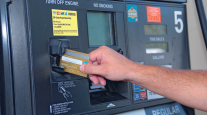Opinion: Small Firms Can Fight Cargo Theft
By Ray McElfish and Jeffrey Lynn
Attorneys
McElfish Law Firm
This Opinion piece appears in the Sept. 19 print edition of Transport Topics. Click here to subscribe today.
Cargo thefts are at an all-time high, but so are innovative new surveillance, tracking and security products their makers claim can prevent or reduce thefts or hijacking and help locate stolen freight — for a price.
Unfortunately, most of the new products are too expensive for small- to medium-sized trucking companies, which are more inclined to invest their limited technology dollars in software for dispatch, cost-tracking and maintenance.
However, there are many ways smaller companies can substantially reduce theft simply by adjusting screening processes and modifying travel behavior. The following tips can help:
Always hire drivers in face-to-face interviews. Take photos for your records, and make copies of drivers’ government-issued identification. Ensure that the driver completes the entire application and that the application itself is detailed and includes:
• Driver’s full name.
• Current address.
• Date of birth.
• Social Security number.
• Driver’s license number and state where it was issued.
• Whether the driver’s license ever has been suspended.
At the interview, drivers should be asked to present:
• Valid Class A commercial driver license.
• Social Security card.
• Verifiable employment record for the past three years, including phone numbers.
• Proof of U.S. citizenship or the right to work in the United States.
Don’t skimp on background checks; perform both criminal and credit checks. Wait until the full clearance is complete before hiring anyone.
Ensure that your background check includes felony convictions within the past 10 years as well as parole status, wants and warrants, and any reports of theft or misuse of funds or property in connection with employment.
Also verify whether the driver has ever violated out-of-service orders or used a vehicle in the commission of a felony.
Comply with the U.S. Department of Transportation Compliance, Safety, Accountability program requirements regarding pre-employment screening, particularly with regard to drug testing. Check with previous employers, and, if possible, determine whether the driver has ever failed a drug test.
Do background checks on other employees as well. Unfortunately, many cargo thefts are committed by insiders — or with their help. Employees such as dispatchers, security guards and accounting employees who know delivery schedule loopholes or weaknesses in the supply chain have been known to conspire with drivers to hide cargo or send armed robbers to truck routes and rest stops. Because of this, employees with access to this information should be subject to the same background checks as drivers.
Keep terminals safe. Fence the entire physical premises of company parking lots. Note any unusual behavior near your facility that could mean you are being watched. Be particularly on the alert for:
• Occupied cars parked nearby.
• Individuals taking still photos or video.
• Individuals examining your facility and/or taking notes.
Storage areas should have locks on all windows and doors. Restrict access to loading areas. Have visitors show a photo ID before they can enter your facility. Issue badges to employees and visitors. Repair malfunctioning security devices immediately.
Don’t display information on the outside of a truck that might give thieves too much detail about what’s inside.
Carefully control bills of lading, which specify what each truck will be carrying, when it will depart from the facility, and the serial number of the trailer in which the cargo is being shipped. Always load valuable cargo toward the front of the trailer.
Keep the calendar in mind when planning logistics. Most thefts occur over weekends, so avoid making a Friday pickup that’s scheduled for Monday delivery if it means the load will spend Saturday and Sunday in an unsecured location. If this is unavoidable, at least make sure your policy has “terminal coverage,” which protects the load under your policy when it is in a terminal. But check the requirements, because most policies specify that the trailer must be attached to a covered power unit and be “in due course of transit” to be covered.
Most cargo thefts occur within 200 miles of a load’s origin, so if hours of service and routing necessities allow, instruct drivers to travel at least 200 miles before stopping and/or to travel at least four hours before the first stop, shutting off the engine immediately upon arrival.
With your insurer’s assistance, check routes for locations to be avoided because of high potential for theft and armed robbery. Provide drivers with a list or map of preapproved, secure locations to stop.
Require drivers to contact dispatch when disembarking and embarking and provide their location, reason for being there and the intended length of stay. Have security protocols in place for each location.
In addition to the precautions already mentioned, advise drivers while on the road to:
• Keep tractor windows rolled up until the truck is on the open road.
• Never pick up hitchhikers.
• Call for assistance if they see motorists in trouble — don’t personally stop to help them.
• Lock the cab and roll up the windows when driving in slow-moving traffic.
• Park in crowds and only at reputable truck stops.
• Avoid being predictable — don’t stop at the same rest areas during each trip.
• When possible, back the trailer to a wall at rest stops.
• Choose well-lit lots with functioning security cameras and alarm systems.
• Always carry a 24-hour emergency phone number.
Above all, tell drivers to use common sense when it comes to protecting your cargo — and their job.
The McElfish Law Firm, which has offices in West Hollywood, Calif., has a core practice of insurance defense and transportation law.




